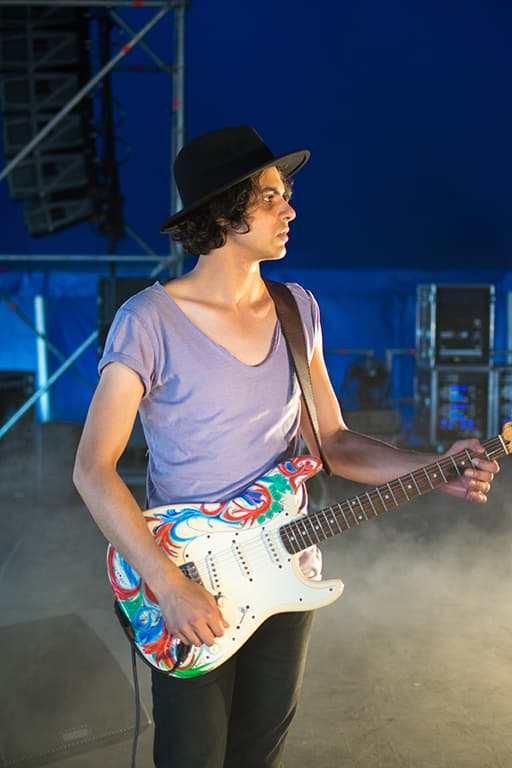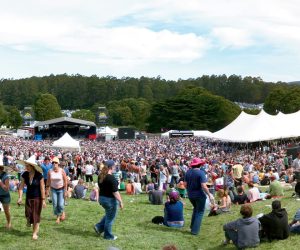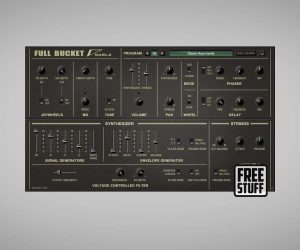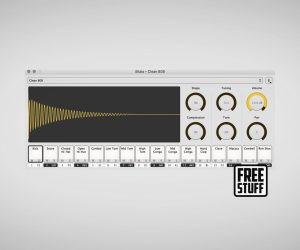
Falls Beats the Heat
When Christmas Day bushfires rocked up on the doorstep of Falls Festival’s Lorne site, the team had just 40 hours to relocate a festival that usually takes weeks to set up. AT went along to find out how.
It wasn’t the Christmas present Falls’ organisers were hoping for. Instead of a cruisy setup day, they were faced with the biggest call they’d ever had to make. Either stay; transplant a music festival for 15,000 people just two days before doors open; or call the whole thing off.
Unfortunately, just as music festivals go hand in hand with the Australian summer, so do bushfires. The odds of the two meeting one day was probably significant. Recently, that number came up twice. On Christmas Day, Falls Festival was chased off its traditional stomping ground in Lorne, and then, across the other side of the country in Perth, bushfires also forced Southbound Festival to cancel its main event.
You don’t play with fire. Especially when a mass exodus would make the only road out of your music festival look like a balloon artist was squeezing its midsection. Sure there was a fire plan, there always is. “But you can’t take that risk,” said Falls’ production manager, Ade Barnard. “Not with one person’s life, let alone 15,000.”
Arriving at Mt Duneed Estate after midday on New Year’s Eve, it was obvious that electing to relocate was the right move. There were supposedly 16,000 people on site but not one was out in the open. Bands hadn’t started playing on the main Valley Stage yet so everyone was either watching Money For Rope in the Grand Theatre tent or huddled under one of the shade canopies to escape the 40-degree heat. Even as far back as Boxing Day — when the fire was still seven or eight kilometres away from the Lorne site — New Years Day was the one organisers were really worried about. “The CFA said if it did kick,” said Barnard. “It would cross the ground really fast.”
The decision to move a festival isn’t made lightly. Sure, the losses from cancelling a festival are heavy, but so is the responsibility of delivering a quality event in a short timeframe. It’s not just a question of, ‘Should we?’ But also, ‘Can we?’ Apart from somehow communicating the news to every festival-goer, you have to set up a completely new campsite — including toilets, showers, water, power, fencing, amenities, the list goes on — deliver all new staging and production, brief all your crew about a new set of protocols and how to direct people around a site they’ve never set foot on before. There’s loads more than that, and it all had to be done in a couple of days.
Not wanting to make things too easy, Falls also ran off 1200 extra New Year’s Eve-only tickets that raised over $120,000 for the Great Ocean Road bushfire relief. The organisers of Southbound Festival also managed to put together a benefit concert that raised over $150,000 for bushfire victims.
AudioTechnology sat down with Ade Barnard (who co-owns Monitor City) on New Years Eve to run through the order of events. Here’s an outline of the Herculean effort by all involved.
TIMELINE
19th – 28th December 2015

Usually at Falls we have two setup days to tinker with the PA… here, we officially couldn’t make noise until the first band came on


FALLS IDENTITY CRISIS
Barnard had a little inside help to get him over the line. His friend, Steven ‘Stig’ Moore is the production manager for A Day on the Green, which regularly holds gigs at Mt Duneed. As luck would have it, he’s also part of the Falls team at Marion Bay. Even closer to home was the site manager for A Day on the Green, who was already part of the Falls Lorne team. “He’s done six or seven shows at Mt Duneed Estate,” reckoned Barnard. “And this is his third Falls. Anything we needed to know, he knows it.”
In any case, Barnard stressed, Falls isn’t A Day on the Green. Putting on Falls Festival primarily requires Falls insider knowledge. Each festival has its own identity, and Falls has been running in the same slice of Otways forest for over two decades. While they couldn’t replicate the exact conditions, it was important that the layout was familiar to as many long-term festival goers as possible. “This is almost a replica of Falls Lorne,” said Barnard. “The tent and main stage are laid out as close to normal as we could get it. That way, the people who always come to Falls experience the same vibe.”
Barnard held two different perspectives of the festival relocation. On one hand, “it’s easy, we just had to duplicate it again,” he said. “The promoters were great, ‘The doors open at midday on the 28th. Go! How many people do you need? Just get them.’” But there’s also a sense of disbelief that they actually pulled it off in time. “My lot did an amazing job,” continued Barnard. “There were only 40 hours between when we heard we were moving to when we opened. I don’t know how the site guys did it. Their doors opened three hours before mine, so in 37 hours they had to deliver toilets, showers, parking and three and a half kilometres of fencing, which is hard work.
“Everyone did amazing work, they just did it. At any one time, there would have been 40 people working on production. So when there’s one lot not working, they’re sleeping.
“Everyone has been great. No one in production has profiteered. People took my phone calls on Boxing Day. To be fair, I’m not going to ring them up on Boxing Day just to say, ‘How’s it going?’ People enabled me, in the course of three hours, to find a whole new set of pieces. Without such a great team: the Mediatec broadcast guys, the MPH Australia guys, JPJ, my guys from Monitor City, all the Engine Room stage guys — without that willingness we wouldn’t have been able to do it.”
















RESPONSES